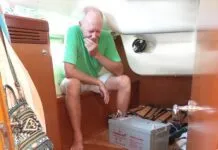Options for securing water at sea during emergency situations have traditionally been limited to solar stills, catchment systems, portable reverse osmosis units, or pre-staging water jugs and jerry cans. These methods all have downsides, however: Solar stills are typically fragile and work poorly in cold or rough weather; manual reverse osmosis units are expensive and require maintenance and considerable effort to operate; catchment systems are weather dependent; and jerry cans are bulky, heavy, and don’t make more water.
There is a fifth choice: Manta Ventures’ SeaPack, a passive, forward-osmosis emergency desalination system. Developed in concert with the U.S. Department of Defense, SeaPack converts saltwater (as well as brackish, muddy, or questionable water) into a high-calorie (230 calories/8 fl. oz.), grape-flavored energy drink. It has no moving parts, no power requirements, doesn’t clog, and requires no manual effort other than filling the I.V.-size bag with water.
SeaPack consists of a filtering membrane bag inside a tough outer bag. Salt water is poured into the outer bag (through the red port) while a 4-ounce “sugar charge” is squirted into the inner bag via the green port. The sugar solution, which is required for operation, provides both the catalyst for the osmosis process (pulling fresh water from the saltwater) and the basis for the nutrient drink. The drink produced is very high in sugars (comparable to pressed grapes, per the manufacturer), and although beneficial in a survival situation, it is not intended for long-term use.
Once the SeaPack has been filled with water and charged with the sugar solution, it’s simply a matter of waiting for the desalination process to finish (it stops automatically when the sugar charge is completed). The wait time depends on air temperature, and it ranges from 8.6 hours (at 33.8 degrees F) to 3.6 hours at 95 degrees F. Each sugar charge produces a half-liter (1 pint) drink.
Once the process is completed, you can drink from the unit or pour the liquid into another container and start the process over to produce additional fluid. The SeaPack unit has a guaranteed shelf life of three years. (The filter has an indefinite shelf life, however, the sugar charges may caramelize after three years, depending on storage temperature.) Once activated, the filter can be used continually for 10 days, after which it must be replaced.
So how much energy drink can be produced during that 10-day window? That depends on temperature and how many sugar charges you have. For the sake of illustration, let’s say the temperature is a constant 86 degrees F, the unit is good for exactly 10 days (240 hours), and that you have 60 sugar charges. At 86 degrees, the unit should produce 1 pint every four hours, so theoretically you could produce 7.5 gallons (60 pints) in 10 days. This barely meets the daily survival requirement for one person.
Test results
Prior to using the SeaPack, Practical Sailor testers prepped the unit following the manufacturer’s instructions. Next we squirted one of the supplied sugar charges into the inner bag (green port) and let modern technology do its thing. The instructions state the unit will produce 1 pint of drink in roughly five hours with an air temperature of 68 degrees F. Air temperature during our test ranged from 60 to 65 degrees, so we gave it six hours, during which time the SeaPack produced 2½ cups or approximately .59 liters (1¼ pints).
Bottom Line: A SeaPack kit, which includes one filter unit and five sugar charges (stored in a waterproof dry storage bag) retails for $120, or $24 per pint. (Additional sugar charges can be purchased: 5 for $30, or $6 per pint). A pint’s worth of life raft water pouches come out at about a $1.20. A hand-pump reverse-osmosis unit like the Katadyn Survivor 06 retails for about $575. Sure, pure water doesn’t offer the caloric supplement of the Seapack, but there are easier ways to meet calorie needs in a life raft than by brewing.
For the island hopper, the Sea Pak offers a compact way to supplement the life raft’s emergency water rations (which we’d never completely omit), but for the ocean voyager’s life raft or overboard kit, a portable reverse-osmosis device makes much better sense to us.
Seapack, 757/619-3614
sea-pack.com




































